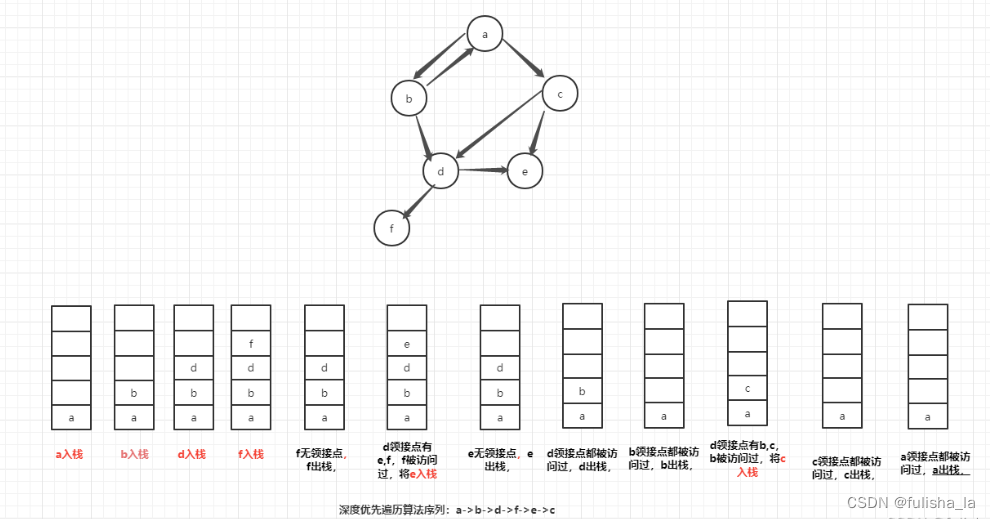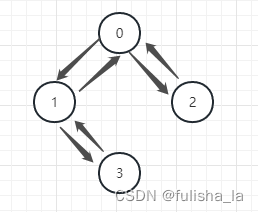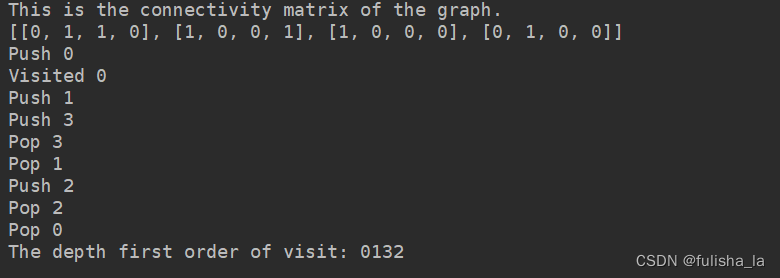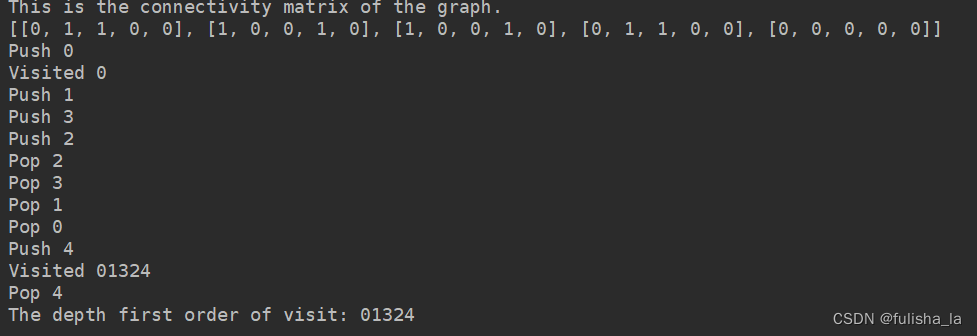日撸 Java 三百行day34

说明
闵老师的文章链接: 日撸 Java 三百行(总述)_minfanphd的博客-CSDN博客
自己也把手敲的代码放在了github上维护:https://github.com/fulisha-ok/sampledata
Day34 图的深度优先遍历
1.思路
相比于广度优先遍历,深度优先遍历是往深度遍历,深度遍历更像是树的先根遍历。深度遍历借助栈来实现,如下图,从a节点出发,先访问a后再将a入栈,直到访问到f无法再往深度访问则是就往回溯,回溯上一个节点,看他的领接点,再对领接点进行深度遍历,最后将节点都遍历完。

根据上图画出相应的矩阵
Δ a b c d e f a 0 1 1 0 0 0 b 1 0 0 1 0 0 c 0 0 0 1 1 0 d 0 0 0 0 1 1 e 0 0 0 0 0 0 f 0 0 0 0 0 0 \\begin{array}{c} % 总表格 \\begin{array}{c|cccc} % 第二行 Delta 值数组 \\Delta & a & b & c & d & e & f \\\\ \\hline a & 0 & 1 & 1 & 0 & 0 & 0 \\\\ b & 1 & 0 & 0 & 1 & 0 & 0 \\\\ c & 0 & 0 & 0 & 1 & 1 & 0\\\\ d & 0 & 0 & 0 & 0 & 1 & 1 \\\\ e & 0 & 0 & 0 & 0 & 0 & 0 \\\\ f & 0 & 0 & 0 & 0 & 0 & 0 \\\\ \\end{array} % 第二行表格结束 \\end{array} % 总表格结束 Δabcdefa010000b100000c100000d011000e001100f000100
假如我们从a点出发,我们初始化栈时,会将a压入栈中。现在a出栈,同时a的领接点b入栈;接下来将b的领节点d入栈;再将d的领节点(e或f)入栈,这里选择f, 发现f没有领结点,则是就开始回溯,f出栈,然后d出栈,判断d的领结点有没有访问过,发现f被访问过,e没有,则将e压入栈中,然后又从e节点开始往下深度找,和上面步骤一样。在这个过程中主要注意有几点:
- 1.何时入栈
当所访问的节点还有邻结点且没有被访问,则继续将孩子节点进行入栈 - 2.何时出栈
当发现访问节点没有孩子节点,自己就需要出栈,且要往回回溯节点。
2.代码
在深度遍历的代码中,while(true)这个循环一定要有退出循环的条件,不然会进入死循环。在循环中的tempNext变量则是往深度找节点的变量,当往最深不能再走,则节点出栈(栈:先进后出)回溯。
- 和day33代码一样,如果有多个连通分量 可能回漏掉结点,所以也加了一个判断,tempVisitedArray,resultString作为成员变量,breadthTraversal和depthTraversal方法是保证所有结点都能访问到,在方法开始前都会重新初始化tempVisitedArray,resultString这两个变量。
代码如下:
package graph;import datastructure.queue.CircleObjectQueue;
import datastructure.stack.ObjectStack;
import matrix.IntMatrix;import java.time.Year;/* @author: fulisha* @date: 2023/4/18 15:43* @description:*/
public class Graph {IntMatrix connectivityMatrix;/* The first constructor.* @param paraNumNodes The number of nodes in the graph.*/public Graph(int paraNumNodes){connectivityMatrix = new IntMatrix(paraNumNodes, paraNumNodes);}/* The second constructor.* @param paraMatrix The data matrix.*/public Graph(int[][] paraMatrix){connectivityMatrix = new IntMatrix(paraMatrix);}@Overridepublic String toString(){return "This is the connectivity matrix of the graph.\\r\\n" + connectivityMatrix;}/* Get the connectivity of the graph.* @return*/public boolean getConnectivity() throws Exception {// Step 1. Initialize accumulated matrix.IntMatrix tempConnectivityMatrix = IntMatrix.getIdentityMatrix(connectivityMatrix.getData().length);//Step 2. InitializeIntMatrix tempMultipliedMatrix = new IntMatrix(connectivityMatrix);//Step 3. Determine the actual connectivity.for (int i = 0; i < connectivityMatrix.getData().length - 1; i++){// M_a = M_a + M^ktempConnectivityMatrix.add(tempMultipliedMatrix);// M^ktempMultipliedMatrix = IntMatrix.multiply(tempMultipliedMatrix, connectivityMatrix);}// Step 4. Check the connectivity.System.out.println("The connectivity matrix is: " + tempConnectivityMatrix);int[][] tempData = tempConnectivityMatrix.getData();for (int i = 0; i < tempData.length; i++) {for (int j = 0; j < tempData.length; j++){if (tempData[i][j] == 0){System.out.println("Node " + i + " cannot reach " + j);return false;}}}return true;}/* Unit test for getConnectivity.*/public static void getConnectivityTest(){int[][] tempMatrix = { { 0, 1, 0 }, { 1, 0, 1 }, { 0, 1, 0 } };Graph tempGraph2 = new Graph(tempMatrix);System.out.println(tempGraph2);boolean tempConnected = false;try {tempConnected = tempGraph2.getConnectivity();} catch (Exception ee) {System.out.println(ee.getMessage());}System.out.println("Is the graph connected? " + tempConnected);//Test a directed graph. Remove one arc to form a directed graph.tempGraph2.connectivityMatrix.setValue(1, 0, 0);tempConnected = false;try {tempConnected = tempGraph2.getConnectivity();} catch (Exception ee) {System.out.println(ee);}System.out.println("Is the graph connected? " + tempConnected);}/* Breadth first Traversal* @param paraStartIndex The start index.* @return The sequence of the visit.*/boolean[] tempVisitedArray;String resultString = "";public String breadthFirstTraversal(int paraStartIndex) {CircleObjectQueue tempQueue = new CircleObjectQueue();int tempNumNodes = connectivityMatrix.getRows();// Initialize the queuetempVisitedArray[paraStartIndex] = true;resultString += paraStartIndex;tempQueue.enqueue(paraStartIndex);//Now visit the rest of the graph.int tempIndex;Integer tempInteger = (Integer) tempQueue.dequeue();while (tempInteger != null){tempIndex = tempInteger.intValue();//Enqueue all its unvisited neighbors.for (int i = 0; i < tempNumNodes; i++){if (tempVisitedArray[i]){// Already visited.continue;}if (connectivityMatrix.getData()[tempIndex][i] == 0) {//Not directly connected.continue;}tempVisitedArray[i] = true;resultString += i;tempQueue.enqueue(i);}//Take out one from the head.tempInteger = (Integer)tempQueue.dequeue();}return resultString;}/* Judge connectivity* @param* @return*/public boolean breadthTraversal(int paraStartIndex) {int tempNumNodes = connectivityMatrix.getRows();tempVisitedArray = new boolean[tempNumNodes];resultString = "";breadthFirstTraversal(paraStartIndex);for (int i = 0; i < tempNumNodes; i++){if (!tempVisitedArray[i]){breadthFirstTraversal(i);return false;}}return true;}public String depthFirstTraversal(int paraStartIndex) {ObjectStack tempStack = new ObjectStack();int tempNumNodes = connectivityMatrix.getRows();tempVisitedArray = new boolean[tempNumNodes];tempVisitedArray[paraStartIndex] = true;resultString += paraStartIndex;tempStack.push(new Integer(paraStartIndex));System.out.println("Push " + paraStartIndex);System.out.println("Visited " + resultString);int tempIndex = paraStartIndex;int tempNext;Integer tempInteger;while (true) {tempNext = -1;// Find an unvisited neighbor and pushfor (int i = 0; i < tempNumNodes; i++) {if (tempVisitedArray[i]) {continue; //Already visited.}if (connectivityMatrix.getData()[tempIndex][i] == 0) {continue; //Not directly connected.}tempVisitedArray[i] = true;resultString += i;tempStack.push(new Integer(i));System.out.println("Push " + i);tempNext = i;break;}if (tempNext == -1) {//there is no neighbor node, poptempInteger = (Integer) tempStack.pop();System.out.println("Pop " + tempInteger);if (tempStack.isEmpty()) {//No unvisited neighbor。Backtracking to the last one stored in the stackbreak;}else {tempInteger = (Integer) tempStack.pop();tempIndex = tempInteger.intValue();tempStack.push(tempInteger);}} else {tempIndex = tempNext;}}return resultString;}public boolean depthTraversal(int paraStartIndex){int tempNumNodes = connectivityMatrix.getRows();tempVisitedArray = new boolean[tempNumNodes];resultString = "";depthFirstTraversal(paraStartIndex);for (int i = 0; i < tempNumNodes; i++){if (!tempVisitedArray[i]){depthFirstTraversal(i);return false;}}return true;}public static void depthFirstTraversalTest() {// Test an undirected graph.//int[][] tempMatrix = { { 0, 1, 1, 0 }, { 1, 0, 0, 1 }, { 1, 0, 0, 0}, { 0, 1, 0, 0} };int[][] tempMatrix = { { 0, 1, 1, 0 , 0}, { 1, 0, 0, 1, 0 }, { 1, 0, 0, 1, 0}, { 0, 1, 1, 0, 0}, { 0, 0, 0, 0, 0} };Graph tempGraph = new Graph(tempMatrix);System.out.println(tempGraph);String tempSequence = "";try {//tempSequence = tempGraph.depthFirstTraversal(0);tempGraph.depthTraversal(2);} catch (Exception ee) {System.out.println(ee);} // Of try.System.out.println("The depth first order of visit: " + tempGraph.resultString);}public static void breadthFirstTraversalTest() {// Test an undirected graph.//int[][] tempMatrix = { { 0, 1, 1, 0 }, { 1, 0, 0, 1 }, { 1, 0, 0, 1}, { 0, 1, 1, 0} };//int[][] tempMatrix = { { 0, 1, 1, 0 , 0}, { 1, 0, 0, 1, 0 }, { 1, 0, 0, 1, 0}, { 0, 1, 1, 0, 0}, { 0, 0, 0, 0, 0} };int[][] tempMatrix = { { 0, 1, 1, 0 , 0, 0, 0}, { 1, 0, 0, 1, 0, 0, 0 }, { 1, 0, 0, 1, 0, 0, 0}, { 0, 1, 1, 0, 0, 0, 0}, { 0, 0, 0, 0, 0, 1, 1}, { 0, 0, 0, 0, 1, 0, 0}, { 0, 0, 0, 0, 0, 0, 0} };Graph tempGraph = new Graph(tempMatrix);System.out.println(tempGraph);String tempSequence = "";try {tempGraph.breadthTraversal(2);//tempSequence = tempGraph.breadthFirstTraversal(2);} catch (Exception ee) {System.out.println(ee.getMessage());return;}System.out.println("The breadth first order of visit: " + tempGraph.resultString);}public static void main(String[] args) {System.out.println("Hello!");Graph tempGraph = new Graph(3);System.out.println(tempGraph);// Unit test.getConnectivityTest();breadthFirstTraversalTest();depthFirstTraversalTest();}}-
单元测试1(文章中给出的例子)

从0开始出发:

-
单元测试2

从0开始出发:

-
单元测试3
从0开始:


3.总结
在对树或图遍历的时候,根据他们的结构,我们都需要保存访问的节点。
1.在广度遍历中借助了队列
在进行图的广度遍历可以结合树的层次遍历,先说树的层次遍历,它需要一层一层的遍历节点当第一层节点遍历完了,如何找到第二层节点?第二层是上一层的孩子节点,所以第一层访问后将要将节点保存起来,选择存储的结构可以是栈或队列。队列(先进先出)出栈是从左到右的顺序,这更符合我们的读写顺序,用栈(先进后出)来实现则出栈顺序就会很混乱,所以层次遍历使用队列。进一步,在对图的广度遍历,我们更愿意借助队列来实现遍历。
2.在深度优先遍历借助了栈。
在对树进行先序遍历时,我们访问完节点后,需要把节点保存,存储我们也可以选择栈和队列,若使用队列,因为队列特点先进先出,进队列顺序可以,但是在出队列时需要的结点在队尾。因此队列无法达到遍历的要求,但是栈先进后出更适合。进一步我们图的深度遍历会更先弄考虑的是栈。
列和栈特点可以在很多地方应用,例如逆向打印数据,顺序输入数据进入栈在输出时可以逆序打印。(例如Day26:: 二叉树深度遍历的栈实现 (前序和后序))


